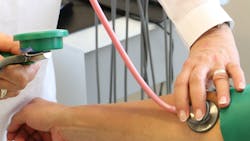“COVID Line Team" eases ICU burden
A cross-institutional team of physicians from Cedars-Sinai have created “COVID Line Team,” Serving as Hub for Placing Central and Arterial Lines in Critically Ill COVID-19 Patients, allowing intensive care unit (ICU) staff to concentrate on patient care, reported the health system.
Throughout the COVID-19 crisis, Cedars-Sinai employees have stepped-up and stepped-in to support patients and colleagues alike. And while there has been no shortage of selflessness, one group of volunteers shines a bright light on both the innovation and teamwork spurring from the past 10 months of treating the sickest of patients.
“We saw a need and quickly identified a solution,” said Evan Zahn, MD, a congenital heart disease expert, when recalling how the innovative idea came to be.
The medical innovation was first conceived by Eduardo Marbán, MD, PhD, executive director of the Smidt Heart Institute and the Mark S. Siegel Family Foundation Distinguished Professor, last March after Zahn went to him volunteering his services in response to the COVID-19 crisis. Marbán realized that Zahn might be able to fill a huge need in expediting care of the sickest COVID-19 patients: Zahn’s special skills include inserting “lines”—thin plastic tubes placed meticulously into arteries or veins — to monitor blood pressure, oxygen levels and fluid status. Such lines, whether placed centrally into a large vein in the neck or leg, or into an artery in the arm, were taking ICU doctors and nurses roughly 60 to 90 minutes to place in patients with COVID-19: The processes are difficult to begin with and made more so by having to be performed using personal protective equipment and other precautions against the aerosolized virus.
The innovative concept was to create and deploy a squad of physicians highly skilled in placing central lines and arterial lines, to enable the primary ICU team to take care of critically ill COVID-19 patients without distraction. Cardiac interventionalists, like Zahn, routinely place central lines in patients multiple times a day and therefore, can do it in less time. Zahn himself had the added benefit of doing so in the tiniest of infants, as part of his work as a pediatric cardiologist, making it that much easier for him to place lines in adult patients.
“Our ICU care teams didn’t have upward of 60 minutes to spend donning and doffing PPE to perform these bedside procedures,” said Zahn, director of the Guerin Family Congenital Heart Program in the Smidt Heart Institute. “Their time needed to be spent on caring for, and treating, the sickest of patients.”
So, under Zahn’s leadership, a strictly voluntary “COVID line team” was quickly formed last March –comprising roughly 20 doctors with special expertise in placing these lines. Within hours of the initial ask, Zahn said dozens of highly skilled and experienced physicians called to volunteer.
Over the summer months, the number of admitted COVID-19 patients dipped at Cedars-Sinai, which meant fewer members of the central line team were needed. But over the last three weeks, as cases began to climb rapidly, the need for the volunteer group became urgent once again.
“The line team’s work allows our ICU clinicians to focus their efforts where they are most needed, while giving our patients the benefit of receiving vascular access from a highly skilled group of physicians,” said Michael Nurok, MD, PhD, medical director of the Cardiac Surgery Intensive Care Unit in the Smidt Heart Institute.
Robert Wong, MD, director of Medical Student Education in the Department of Anesthesiology at Cedars-Sinai, has been the point person for the complex logistics involved in making the line team function. Zahn and Wong see no end in sight for the voluntary central line team, as cases are projected to continue rising in the wake of Christmas and New Year’s celebrations.
“We are now performing these procedures in numbers we haven’t seen before,” said Zahn. “The number of patients is unprecedented, and we are doing our best to support our incredible ICU care team heroes. These selfless individuals, our ICU nurses, respiratory technicians and doctors, are the real story.”





